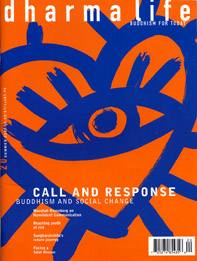Vajrayogini
Her Visualisations, Rituals and Forms
A Study of the Cult of Vajrayogini in India
Elizabeth English
Wisdom 2002, $34.95/£28.95 p/b
The image of the dakini Vajrayogini with her lithe, brilliant-red naked body, bone adornments and halo of flames has caught the imagination of Indo-Tibetan Buddhists down the centuries. The literary attention she has received in recent years suggests this is still the case today. The Highest Yoga Tantra practice of Vajrayogini seems to be one of the most popular in Tibetan Buddhist circles and several lengthy commentaries have recently been published on the once strictly secret teachings of the Vajrayogini practice.
Vajrayogini is also the principal figure in Judith Simmer-Brown's excellent recent study Dakini's Warm Breath, which explores the dakini from the perspective of the practice traditions in which she is prominent. With the appearance of Elizabeth English's book, further light is shed on this mysterious, multivalent deity and the early development of her cult in India.
The higher tantras and associated figures such as Vajrayogini are often thought of as 'Tibetan' because these practices are prominent in Tibetan Buddhism. However, as this book shows, the cult of Vajrayogini developed in India from around the 10th century ce. The practices were eagerly transmitted to Tibet by contemporary translator-practitioners, such as Marpa, the famed disciple of Naropa and guru of Milarepa.
This book is primarily a study of a unique collection of sadhanas (practice texts) centred on various forms of Vajrayogini, known as the Guhyasamayasadhanamala, and in particular of a sadhana to Vajravarahi, 'Diamond Sow,' a prominent form of Vajrayogini. It is scholarly, but written with a genuine passion for the subject and far from being an academic tome. Apart from its obvious interest to academic specialists, it will also appeal to devotees of Vajrayogini, as well as those interested in Buddhist tantra generally.
For non-specialists the most stimulating chapters are those which place the Vajrayogini practices in their historical context, describe the Vajravarahi practice in detail, and evoke the many strange forms of Vajrayogini that appear in the Guhyasamayasadhanamala. Only a few forms of Vajrayogini became popular in Tibetan Buddhism, and this part of the book contains line drawings of forms both erotic and wrathful that have been reconstructed from the sadhana descriptions, as no known traditional representations exist. Indeed, as well as being lucidly written, the book is beautifully produced and illustrated, including 16 colour plates with rare and ancient paintings of the goddess.
Tejananda is Chairman of Vajraloka Retreat Centre in Wales



